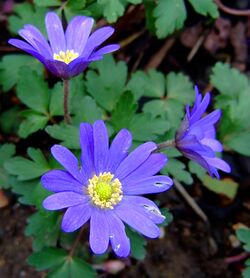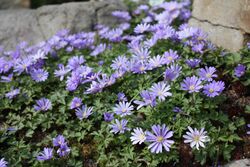Biology:Anemone blanda
| Anemone blanda | |
|---|---|

| |
| Scientific classification | |
| Kingdom: | Plantae |
| Clade: | Tracheophytes |
| Clade: | Angiosperms |
| Clade: | Eudicots |
| Order: | Ranunculales |
| Family: | Ranunculaceae |
| Genus: | Anemone |
| Species: | A. blanda
|
| Binomial name | |
| Anemone blanda | |
Anemone blanda, common names Balkan anemone,[2] Grecian windflower or winter windflower, is a species of flowering plant in the family Ranunculaceae, native to southeastern Europe, Turkey, Lebanon, and Syria. The specific epithet blanda means "mild" or "charming".[3] The genus name is derived from the Greek word anemos, or wind.[4]
Description
An herbaceous tuberous perennial, it grows up to 4-6 inches tall, or 10-15 cm.[5] It is valued for its daisy-like flowers over a fernlike foliage,[5] which appear in early spring, a time when little else is in flower. The plants can also easily naturalize.[5] The flowers are an intense shade of purple blue, but are also available in shades of pink and white.
Cultivation
Anemone blanda should be planted in the autumn in partially shady areas, and in moist soil. It can also grow in full sun if the soil stays moist.[5] It grows in any well-drained soil which dries out in summer; hence it is often used for underplanting deciduous trees which provide the necessary conditions. It rapidly colonizes any favored location. The plant is deciduous, meaning the flowers and leaves die in the early summer.[6] The flowers attract bees, butterflies and other pollinators.[7] This plant[8] and its cultivar ‘White Splendour’,[9] have gained the Royal Horticultural Society's Award of Garden Merit.
Medicinal uses
Herbalists in the Middle Ages used Anemone blanda as treatment for gout and headaches. Due to their toxicity, Anemone blanda are no longer used as medications. The purple colored petals of the plant were used for dyeing purposes by boiling them to produce a light green color. [10]
Toxicity
Anemone blanda is considered to be poisonous if ingested in large quantities, and causes pain and irritation in the mouth. The plant can cause contact dermatitis by touching of the following poisonous parts of the plant: bark, flowers, fruits, leaves, roots, stems, and seeds. Some other symptoms of being poisoned are inflammation, blistering from contact with fresh sap, vomiting, and diarrhea. [11]
Leaves
The green leaves are finely divided and arranged in a whorled and alternate pattern. They do not contain hair like structures. [11] The leaves are deeply cut.[12] The plant has compound leaves that are grown in basal arrangement. The edges of the blades of leaves contain teeth.[13]
Roots and stems
The stem of the plant is nonaromatic[11] and has wire-like stems.[7] Anemone blanda have little root growth so its normal for them to only produce few roots.[14] The perennial is tuberous-rooted.[4]
Fruits and flowers
Flower of Anemone blanda are found in various colors and are radially symmetrical. The flower contains about seven or more sepals and petals.[13] The flowers have an attractive, striking appearance with dull centers and smooth, satiny, vibrant petals. [14]The flowers come in colors like white, yellow-green, red, or purple, and more. They are shaped like cups, with several stamens.[15] The plant contains small fruits, frequently including plumose tails.[11] The fruits of this plant are dry and do not split open after they ripe. They are about 1.3 to 3 mm in size. [13]
Pollination
Bees and pollinators are attracted towards Anemone blanda; this plant has nectar and pollen rich flowers. [16]
Seeds and bulbs
The Grecian windflower grows from bulb-like tubers.[14] The tubers appear to be black in color and are non-uniformly shaped, small, wrinkled pellets. The tubers do not contain a thin, paper-like sheath. Viable tubers have a firm texture. The minimum size of a tuber of Anemone blanda is 5 cm, but they can be larger in size.[7] Seeds of Anemone blanda have low germination rates, but rates can be increased using stratification. [17]
References
- ↑ "Anemone blanda", The Plant List, http://www.theplantlist.org/tpl1.1/record/kew-2638070, retrieved 2014-10-23
- ↑ "BSBI List 2007" (xls). Botanical Society of Britain and Ireland. Archived from the original on 2015-01-25. https://www.webcitation.org/6VqJ46atN?url=http://www.bsbi.org.uk/BSBIList2007.xls. Retrieved 2014-10-17.
- ↑ Harrison, Lorraine (2012). RHS Latin for gardeners. United Kingdom: Mitchell Beazley. pp. 224. ISBN 9781845337315.
- ↑ 4.0 4.1 "Anemone blanda - Plant Finder". https://www.missouribotanicalgarden.org/PlantFinder/PlantFinderDetails.aspx?taxonid=286103&isprofile=0&.
- ↑ 5.0 5.1 5.2 5.3 "Anemone blanda (Grecian Windflower)" (in en). https://www.gardenia.net/plant-variety/anemone-blanda-grecian-windflower.
- ↑ "Anemone blanda" (in en). https://www.seasonalgardening.co.uk/bulbs/anemone-blanda.asp.
- ↑ 7.0 7.1 7.2 "Anemone blanda Hort Tips". https://www.vanengelen.com/hanemoneblanda.html.
- ↑ "RHS Plant Selector - Anemone blanda". https://www.rhs.org.uk/Plants/25512/Anemone-blanda/Details. Retrieved 14 February 2020.
- ↑ "RHS Plantfinder - Anemone blanda ‘White Splendour’". Royal Horticultural Society. 2017. https://www.rhs.org.uk/Plants/90635/Anemone-blanda-White-Splendour/Details. Retrieved 18 February 2020.
- ↑ "Anemones! All About Anemone Bulbs". https://www.farmergracy.co.uk/blogs/farmer-gracys-blog/all-about-anemone-bulbs.
- ↑ 11.0 11.1 11.2 11.3 "Anemonoides blanda (Anemones) | North Carolina Extension Gardener Plant Toolbox". https://plants.ces.ncsu.edu/plants/anemonoides-blanda/.
- ↑ "Anemone blanda" (in en). https://www.seasonalgardening.co.uk/bulbs/anemone-blanda.asp.
- ↑ 13.0 13.1 13.2 "Anemone blanda (Greek windflower): Go Botany". https://gobotany.nativeplanttrust.org/species/anemone/blanda/.
- ↑ 14.0 14.1 14.2 "All About Anemones". https://www.longfield-gardens.com/article/all-about-anemones.
- ↑ "Anemonoides blanda (Anemones) | North Carolina Extension Gardener Plant Toolbox". https://plants.ces.ncsu.edu/plants/anemonoides-blanda/.
- ↑ "Anemone blanda" (in en). https://www.gardenersworld.com/plants/anemone-blanda/.
- ↑ Clark, Joan. "Anemone: planting, care and cultivation of the flower" (in en). https://floristics.info/en/garden/3005-anemone-planting-care-and-cultivation-of-the-flower.html.
External links
Wikidata ☰ Q805035 entry


